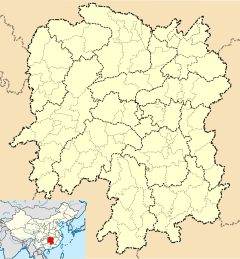Hongshan Temple
| Hongshan Temple | |
|---|---|
洪山寺 | |
 Shanmen, Hongshan Temple | |
| Religion | |
| Affiliation | Buddhism |
| Sect | Linji school |
| Leadership | Shi Zenghui |
| Location | |
| Location | Hongshan Subdistrict, Kaifu District of Changsha, Hunan, China |
| Geographic coordinates | 28°15′56″N 113°02′12″E / 28.265585°N 113.036554°E |
| Architecture | |
| Style | Chinese architecture |
| Completed | August 1993 (reconstruction) |
Hongshan Temple (Chinese: 洪山寺; pinyin: Hóngshān Sì) is a Buddhist temple located in Hongshan Subdistrict, Kaifu District of Changsha, Hunan, China.[1]
History
[edit]According to Volume 31 of Changsha County Annals, Hongshan Temple was established by a landlord surnamed Zhou during the Ming dynasty (1368–1644), and later the local people raised funds to rebuild and rename it "Lufeng Temple".[2]
During the Qing dynasty (1644–1911), Hong Xiuquan led the Taiping army through Changsha and saw the "imperial seal" on the plaque in the front hall.[3] Hong Xiuquan ordered his subordinates to demolish the front hall and mountain gate.[3] His subordinates saw the inscription "Hong" on the plaque, and Hong Xiuquan ordered his subordinates to rebuild the temple.[3] The rear hall of Hongshan Temple was donated and built by Rao Dongfang, the magistrate of Changsha.[4]
After the establishment of the People's Republic of China in 1949, the government vigorously cracked down on superstition, and the statues and halls of Hongshan Temple were demolished, leaving only a few houses for students to use as classrooms.[5] In 1964, the entire Hongshan Temple was completely destroyed.[5] In 1992, the local people resolved to rebuild Hongshan Temple and obtained approval from the local government.[6] In August 1993, the reconstruction of Hongshan Temple was completed.[6]
Architecture
[edit]Now the existing main buildings include Shanmen, Four Heavenly Kings Hall, Mahavira Hall, Kshitigarbha Hall, Foguang Pagoda, Buddhist Texts Library and side rooms.
Gallery
[edit]References
[edit]- ^ Chen, Xianshu (2002). 长沙地名古迹揽胜 [Historic Sites in Changsha]. Beijing: China Federation of Literary and Art Publishing House. ISBN 7-5059-3535-6.
- ^ Yang, Xigui 2018, p. 236.
- ^ a b c Yang, Xigui 2018, p. 239.
- ^ Yang, Xigui 2018, p. 240.
- ^ a b Yang, Xigui 2018, p. 241.
- ^ a b Yang, Xigui 2018, p. 242.
Bibliography
[edit]- Yang, Xigui, ed. (2018). "Chapter 3 - Scenic Spots and Historic Sites: Hongshan Temple on Lufeng Mountain" 第三章 名胜古迹:麓峰山上洪山庙. 开福山水文化 [Landscape and Culture of Kaifu District]. Changsha, Hunan: Hunan People's Publishing House. ISBN 978-7-5561-2046-8.







